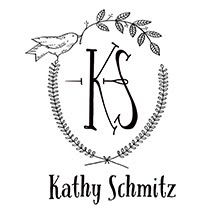
I love looking at old treasures and figuring out how I can make them pretty and useful. I found these sweet silver trophies and a cup at a thrift store and I challenged myself to create a fun project using the designs from my Tiny Treasures book.
The next time you are out and about, keep an eye out for small silver containers like these.
The largest one is 4 1/2" tall with a mouth 2 1/4" wide. I was looking for a size that would hold a ball of Valdani thread. Do you see where I'm going with this?
SUPPLIES:
embroidery fabric
Valdani 12wt pearl cotton
foam core - or heavy cardboard
batting
vintage silver containers/cups
Trace the top (opening) of the cup onto a piece of foam core board or thick corrugated cardboard. Cut out the circle. This circle will be the top (lid).
Trace that circle onto another piece of foam core. This time, cut the circle slightly smaller than the first one. This is IMPORTANT - this circle needs to fit very snug inside the lip of the cup. It shouldn't slip down into the cup itself.
Cut 3 circles of batting the same size as the larger piece of foam core.
I stitched up design #2, the nest and eggs, and then gave it a good pressing from the backside.
I traced the larger foam core circle onto the wrong side of the fabric with the design centered. To see through the fabric, I held them up to a window and used the shadow of the cut-out circle to find the center.
Then I measured an additional 3/4" past the drawn circle and cut out the fabric circle.
Using a heavy thread, I actually used some of the Valdani 12wt pearl cotton, sew a row of basting stitches around the edge of the circle.
Stack the 3 batting circles on top of the larger foam core circle.
Place the batting and larger foam core circle in the center and pull the thread to gather the fabric to the back of the piece. Tie a knot to secure.
Now take long stitches from side to side and pull them tight. The linen I used has a bit of a loose weave so I took a large chunk of the fabric when doing this.
Keep stitching around the entire back until you have a nice finished look on the front.
Now it's time to make the bottom piece.
Cut a circle of fabric larger than the small circle of foam core with about a 1/2" allowance all around.
Make small clips around the edge of the fabric, but not too close to the foam core. Using a glue stick, like this
Sewline Glue Pen, glue and wrap the fabric around the foam core.
This is the bottom of the finished project.
This will be the part that fits snuggly inside of the container.
Now is a good time to check the size. It should be a very tight fight.
Hand stitch the bottom circle to the top circle, wrong sides together. Try to be as neat as you can.
My stitches are small, but they could be a bit neater.
Push the bottom circle inside of the cup. This might take some pressure at first. The foam core is a bit forgiving and it can be wedged in for a tight fit.
Using a Kreinik Custom Corder I made a length of cording the circumference of the cup top plus 3-4" or so.
The rule of thumb I use when making cording is to decide on my finished length x 5. This is the length I cut my DMC floss. I use all 6 strands of the floss.
To see how I make cording, pop over to my YouTube tutorial
HEREUsing 1 strand of the DMC floss, whipstitch the cording to the edge of the top, larger circle - NOT OVER THE SEAM. See photo below.
Leave a tail at the beginning. Tie a knot where the cording meets up and knot and trim the ends.
In this photo, you can see the placement of the cording. It will sit on top of the cup rim.
If you enjoyed this tutorial, make sure you subscribe to my blog.
On your computer, the sign-up tab is on the top right side. On your phone, scroll all the way to the bottom and click "View web version".
Thank you so much!
Kathy

















